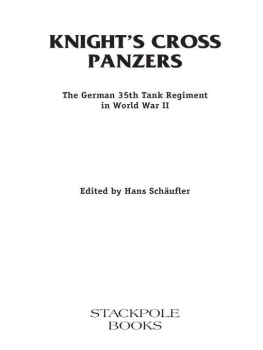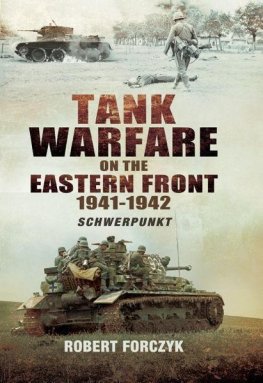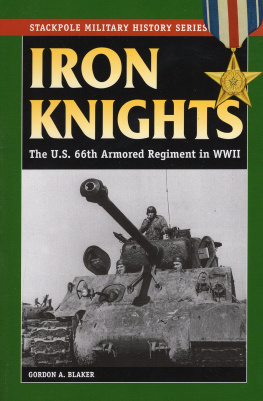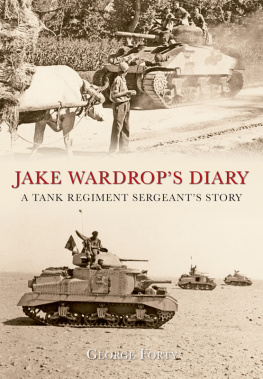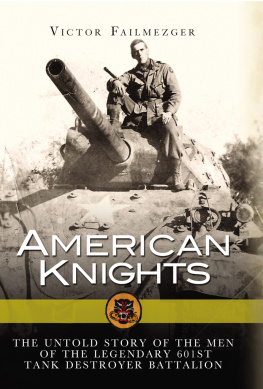Table of Contents
The Stackpole Military History Series
THE AMERICAN CIVIL WAR
Cavalry Raids of the Civil War
Ghost, Thunderbolt, and Wizard
Picketts Charge
Witness to Gettysburg
WORLD WAR I
Doughboy War
WORLD WAR II
After D-Day
Armor Battles of the Waffen-SS, 1943-45
Armoured Guardsmen
Army of the West
Australian Commandos
The B-24 in China
Backwater War
The Battle of Sicily
Battle of the Bulge, Vol. 1
Battle of the Bulge, Vol. 2
Beyond the Beachhead
Beyond Stalingrad
The Brandenburger Commandos
The Brigade
Bringing the Thunder
The Canadian Army and the Normandy Campaign
Coast Watching in World War II
Colossal Cracks
A Dangerous Assignment
D-Day Bombers
D-Day Deception
D-Day to Berlin
Destination Normandy
Dive Bomber!
A Drop Too Many
Eagles of the Third Reich
Eastern Front Combat
Exit Rommel
Fist from the Sky
Flying American Combat Aircraft of World War II
For Europe
Forging the Thunderbolt
For the Homeland
Fortress France
The German Defeat in the East, 1944-45
German Order of Battle, Vol. 1
German Order of Battle, Vol. 2
German Order of Battle, Vol. 3
The Germans in Normandy
Germanys Panzer Arm in World War II
GI Ingenuity
Goodwood
The Great Ships
Grenadiers
Hitlers Nemesis
Infantry Aces
In the Fire of the Eastern Front
Iron Arm
Iron Knights
Kampfgruppe Peiper at the Battle of the Bulge
The Key to the Bulge
Knights Cross Panzers
Kursk
Luftwaffe Aces
Luftwaffe Fighter Ace
Massacre at Tobruk
Mechanized Juggernaut or Military Anachronism?
Messerschmitts over Sicily
Michael Wittmann, Vol. 1
Michael Wittmann, Vol. 2
Mountain Warriors
The Nazi Rocketeers
No Holding Back
On the Canal
Operation Mercury
Packs On!
Panzer Aces
Panzer Aces II
Panzer Commanders of the Western Front
Panzer Gunner
The Panzer Legions
Panzers in Normandy
Panzers in Winter
The Path to Blitzkrieg
Penalty Strike
Red Road from Stalingrad
Red Star under the Baltic
Retreat to the Reich
Rommels Desert Commanders
Rommels Desert War
Rommels Lieutenants
The Savage Sky
Ship-Busters
The Siegfried Line
A Soldier in the Cockpit
Soviet Blitzkrieg
Stalins Keys to Victory
Surviving Bataan and Beyond
T-34 in Action
Tank Tactics
Tigers in the Mud
Triumphant Fox
The 12th SS, Vol. 1
The 12th SS, Vol. 2
Twilight of the Gods
Typhoon Attack
The War against Rommels
Supply Lines
War in the Aegean
Wolfpack Warriors
Zhukov at the Oder
THE COLD WAR / VIETNAM
Cyclops in the Jungle
Expendable Warriors
Flying American Combat Aircraft: The Cold War
Here There Are Tigers
Land with No Sun
Phantom Reflections
Street without Joy
Through the Valley
WARS OF THE MIDDLE EAST
Never-Ending Conflict
GENERAL MILITARY HISTORY
Carriers in Combat
Cavalry from Hoof to Track
Desert Battles
Guerrilla Warfare
Ranger Dawn
Sieges
English translation 2010 by Battle Born Books and Consulting
Published by
STACKPOLE BOOKS
5067 Ritter Road
Mechanicsburg, PA 17055
www.stackpolebooks.com
All rights reserved, including the right to reproduce this book or portions thereof in any form or by any means, electronic or mechanical, including photocopying, recording, or by any information storage and retrieval system, without permission in writing from the publisher.
Printed in the United States of America
10 9 8 7 6 5 4 3 2 1
Library of Congress Cataloging-in-Publication Data
Schufler, Hans, 1912
[So lebten und so starben sie. English]
Knights Cross panzers : the German 35th Tank Regiment in World War II / Hans
Schufler.
p. cm.(Stackpole military history series)
Includes index.
ISBN 978-0-8117-0592-9 (pbk.)
1. Germany. Heer. Panzer-Regiment 35. 2. World War, 1939-1945Regimen
tal historiesGermany. 3. World War, 1939-1945Personal narratives, German.
4. Germany. Heer. Panzer-Regiment 35Biography. 5. Schufler, Hans, 1912- 6.
SoldiersGermanyBiography. 7. World War, 1939-1945Tank warfare. 8. World
War, 1939-1945CampaignsEastern Front. I. Title.
D757.5735th .S33 2010
940.541343dc22
2009053645
Introduction
Panzer-Regiment 35 in Five Years of War
General der Panzertruppen a.D. Heinrich Eberbach
There is no end to the number of unforgettable images conjured up by anyone who was ever a member of this troop. The tankers can still be proud of their regiment to this day; it performed great deeds in battle from the start of the war to the bitter end. Exemplary comradeship, proper behavior towards the enemy and a proper attitude, even in unfortunate times, were the marks of this formation.
Our regiment was not formed until November 1938 as part of the rapid expansion of the German Armed Forces. Insufficiently trained and only equipped with a few Panzer IIIs and IVs , the men marched off to war in Poland less than 10 months after first being activated. But by the eighth day of the campaign, we were outside the gates of Warsawfar in advance of all of the restand we attacked the fortified city without hesitation.
We participated in the first large-scale armored engagement of the war in France, took Armentires in a night attack and advanced through the Weygand Line as far as Isre. I remember the unbelievable chain of victories of our regiment in the first year of the campaign in Russia. At the time, we were part of the 2. Panzer-Armee , which was commanded by Generaloberst Guderian, the creator of the German armored forces and its guiding spirit. He was called fast Heinz by the common foot soldier. He often liked to appear in the middle of the fighting at the regiments location.
It is with gratitude that I also recall the first few battalion commanders of the regimentStenglein, Hochbaum and Lauchert.
The reassignment of our 2nd Battalion to Panzer-Regiment 15 was hard. The battalion performed so well there, that it was difficult to incorporate the Panther battalion back into the fold of the regiment.
The 1st Battalion, whether under the command of Cossel, who was killed, the battalion physician, Knights Cross recipient Doctor Schulz-Merkel or, above all, Schultz, maintained its fame at Kursk and Orel, in the Pripet Marshes and at Kovel.
What the regiment accomplished in Kurland and at Danzig can be well praised by its last commander, my friend, Hans Christern. I am grateful to all of you that you were filled with the same professional attitude at the very end that you were when you initially moved out in 1939.
What was it then that enabled our newly formed regiment to accomplish such unusual success despite minimal prospects? It was a love of homeland and the spirit of the tanker. It pushed us forward, allowed us to engage in the cunning of war and gave us endurance, even when times were bad, and a toughness towards ourselves and a heartfelt comradeship with others. It was pure German military ethos that had the tankers of the regiment storm forward, surprise the enemy again and again, hit hard, enjoy victory and suffer death.

